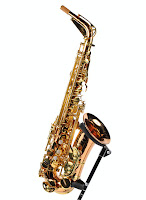Killer Deal Discount on Kenny G Saxophones and Rheuben Allen Saxophones
Here is a deal for those looking to get the Kenny G Saxophones or the Rheuben Allen Saxophones. The 2017 NAMM Show is coming and we need to clear our racks for the NEW Models. Save 10% on Orders over $700.00.
Starting January 6 to January 24, 2017 - Use: NAMM 2017-10 (Only one discount per E-Mail)
Check it out at: https://kdimusic.com/
Improving your Saxophone Playing by Tuning Properly
Tuning Properly
When most saxophonists tune up they use a middle G or F-Sharp. The main problem with this is that the middle G or F-Sharp is traditionally very sharp notes... usually 30 cent plus if the embouchure is not adjusted. The young saxophonist will generally not know where these notes are just by playing them alone. When the student pulls the mouthpiece out far enough to make the unaltered F-Sharp or G play in tune then the lower register of the instrument sill most certainly be flat.
How to fix this problem:
There are two simple things that can be done. One have the saxophonist play the G or F-Sharp in the lower register. These notes are normally much closer to being in tune and will allow the young saxophonist to learn where to play the middle D, D-Sharp, E, F, F-Sharp and G on the alto. To play any of these notes in tune the embouchure must be slightly altered.
The second option is to have the alto saxophonist play a first finger B natural, hold it for a while and then play the middle G or F-Sharp. This will allow the saxophonist to make the necessary adjustments to the embouchure when they hear the interval from the first finger B to the middle note.
Ask any saxophonist of any level of playing to play a middle F-Sharp out of the air as their first note and it will likely not be as in tune as if they played the first finger B before playing the F-Sharp.
*It is important to remember that the saxophone is generally an out of tune instrument. It is by the nature of the design that the instrument is always a challenge to play in tune. When you change a reed... when the room is to hot or cold.... a pad leaks... All of these things change the intonation of the instrument.
*The best way to play any instrument in tune is of course to...... hear it in tune! Practice with your tuner... now they do not need to get crazy with the tuner and bring it with them everywhere... When I see a guy get a tuner out before anyone has played I am pretty sure he cannot trust his ears.... use the tuner at home or just to get the first note where you need it.... then put it away.....
You must first hear in tune to play in tune.....
Thanks for Reading, and please stop by www.kdimusic.com for all the best in Musical Instruments.
Our Motto: “A Passion for the Perfect Sound!”



